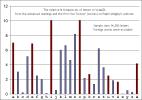 (19,6 KB)
(19,6 KB)Ralph Midgley. Explanation of the correct use of the Volapük word "ad". (19,6 KB)
(19,6 KB)
Letter frequencies. This file contains the paragraphs on the use of upper and lower case initials according to "Gramat Volapüka" by Arie de Jong plus an English translation. (11,3 KB)
(11,3 KB)
1994. Language Lessons.
Description: show1994 Language Lessons 35 min (with Tony Steyger).
Experimental documentary on artificial languages commissioned by Channel 4 and the Arts Council.
“Steve Hawley and Tony Steyger’s Language Lessons mock-documents the scholars and enthusiasts for avant-languages such as Volapuk, Esperanto, and Sol Re Sol (a musically-based language). These invented languages reference concrete or sound poetry and the beauty of sonics unintended for literal and representational communication but rather intended to be heard and then joyfully responded to. The relationship between verbal language and image within experimental film and video art has usually contrasted with its rather literal preeminence within narrative or dramatic traditions. Cause and effect so often having been thrown to the wind, it follows that sentences and even words should not need to be sequential.” Performative Impulses by Andrew James Paterson (2000).
There have been over two thousand invented languages, of which only a handful are still spoken in Britain. Using interviews with speakers of Ido, Esperanto, and Volapük, and rare archive material, Language Lessons examines the history and present state of the artificial language movement.
The lessons take in Logopandecteision, Lips Kith, and the musical language Solresol, which can be whistled and sung as well as spoken. However, the medium of instruction is that most curious of hybrid languages, English.
But behind the rhetoric of world peace through common understanding, lies a background of intense rivalry, genocide, schism, and heresy.
Language Lessons was commissioned by Channel 4 Television and the Arts Council of England, under the Experimenta scheme. It uses humour and irony to explore the nature of eccentricity, of language, and of our anglocentric linguistic culture.
Broadcast Channel 4 Midnight Underground 1995, International Video Festival Friesland 1996, 1996 5th New York Video Festival 1996. In the permanent collection of Fundacio La Caixa , Barcelona.
Music - Joakim Sundström.
Camera - Patrick Duval.
Sound - Cameron Hills.
(Language-Lessons-1994-SD.mp4, 148 MB)
1993. Volapük (Eurotrash).
(Volapük (Eurotrash).webm, 24,9 MB)
Arie de Jong, 1931. English version of Arie de Jong's account of why he revised Volapük. Translated by ‚Hermann Philipps‘.
djforeword.htm (8,26 KB)
Johann Martin Schleyer, 1888. Father Schleyer's description of how he got the idea of inventing the World Language. Konstanz (Deutän). Translated by ‚Hermann Philipps‘.
how_the_inventor.htm (11,9 KB)
1888. Supplementary report of the Committee appointed to consider an international language. Read before The American Philisophical Society..jpg) (5,20 MB)
(5,20 MB)
G. Krause, 1889. The Volapük Commercial Correspondent. With a vocabulary, explanatory notes, and an Appendix by Mr. J. M. Schleyer, containing a nomenclature of the money, weights, and measures of the chief commercial nations in the world. Adapted from R. Kniele's Tedaspod. London (England): Swan Sonnenschein. (23,1 MB)
(23,1 MB)
1890. Report of the Proceedings of the North American Association for the Propagation of Volapük: First Annual Convention. Boston (USA). (19,6 MB)
(19,6 MB)
Frederic W. Mitchell, 1891. A Volapük reader. With special reference to Post's Volapük grammar by Frederic W. Mitchell. Boston (USA). (25,0 MB)
(25,0 MB)
Herbert C. Creed, 1892. Volapük in the schools. Boston (USA).
 (466 KB) | .jpg) (7,57 MB) |
Johann Martin Schleyer, 1895. On the Bungler-Language of the Pseudo-Esperanto. Schleyer's opinion of Esperanto. Konstanz (Deutän). Translated by ‚Hermann Philipps‘ tü yel 2009id.
 (36,9 KB) |  (447 KB) |
Helen Scott Mann, 1931. Lifajenäd hiela ‚Charles Ezra Sprague‘. New York (USA): New York University. (13,6 MB)
(13,6 MB)